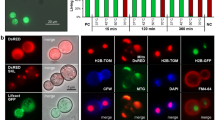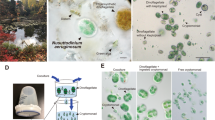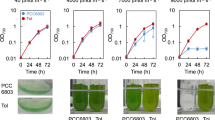Abstract
THE blue-green alga, Cylindrospermum majus Kuetz., forms a characteristic filament with single terminal heterocyst and sub-terminal spore at both ends of the filament. The alga was isolated on Alien and Arnon's nitrogen-free medium1 in axenic cultures. At one stage of the growth cycle most of the filaments of the alga form characteristic spores, which are ellipsoidal with sculptured dark-brown exospore wall.
This is a preview of subscription content, access via your institution
Access options
Subscribe to this journal
Receive 51 print issues and online access
$199.00 per year
only $3.90 per issue
Buy this article
- Purchase on Springer Link
- Instant access to full article PDF
Prices may be subject to local taxes which are calculated during checkout
Similar content being viewed by others
References
Allen, M. B., and Arnon, D. I., Plant Physiol., 30, 366 (1955).
Kumar, H. D., Nature, 196, 1121 (1962).
Author information
Authors and Affiliations
Rights and permissions
About this article
Cite this article
SINGH, R., SINHA, R. Genetic Recombination in a Blue-green Alga, Cylindrospermum majus Kuetz.. Nature 207, 782–783 (1965). https://doi.org/10.1038/207782a0
Issue Date:
DOI: https://doi.org/10.1038/207782a0
This article is cited by
-
Genetic engineering in marine cyanobacteria
Journal of Applied Phycology (1995)
-
Factors modulating differentiation of spores: Characterization of mutants defective in sporulation in the cyanobacterium Anabaena doliolum (AdS strain)
Molecular and General Genetics MGG (1986)
-
Intergeneric transfer of streptomycin-resistance marker between two blue-green algae
Proceedings / Indian Academy of Sciences (1978)
-
Comparative ultrastructure of a filamentous mutant and the wild type ofAgmenellum quadruplicatum
Protoplasma (1970)
-
Action of mutagenic chemicals on Anacystis nidulans
Archiv f�r Mikrobiologie (1970)
Comments
By submitting a comment you agree to abide by our Terms and Community Guidelines. If you find something abusive or that does not comply with our terms or guidelines please flag it as inappropriate.



